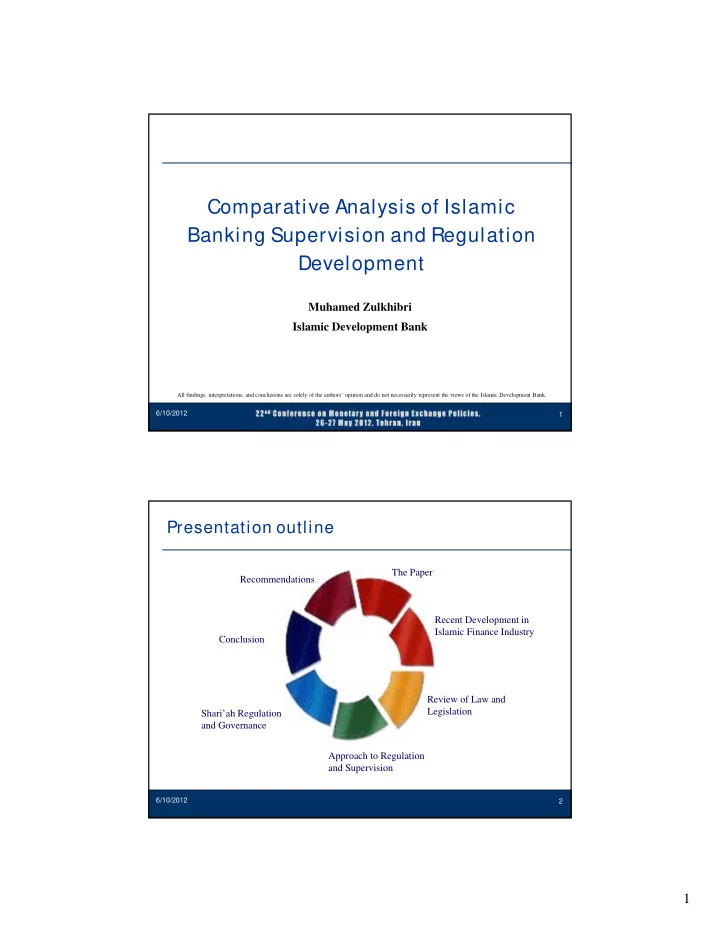

Comparative Analysis of Islamic Banking Supervision and Regulation Development Muhamed Zulkhibri Islamic Development Bank All findings, interpretations, and conclusions are solely of the authors’ opinion and do not necessarily represent the views of the Islamic Development Bank. 6/10/2012 1 Presentation outline The Paper Recommendations Cost push inflation Recent Development in Islamic Finance Industry Conclusion Inflation Inflation Review of Law and Legislation Shari’ah Regulation Cost push and Governance inflation Approach to Regulation and Supervision 6/10/2012 2 1
The paper Motivation: Rapid development but lack of coherent legal framework Lack of uniformity in specific forms of Islamic principles Difficult to generalize Islamic banking in practice Objective: Review the legal and regulatory framework Compare the legal and regulatory framework Focus on 11 IDB member and 2 non-member countries 6/10/2012 3 Recent Developments 6/10/2012 4 6/10/2012 4 2
Rapid development in Islamic financial industry Source: Bank Negara Malaysia, IFSB-IDB-IRTI, various 6/10/2012 5 Total assets of the industry has exceeded US$800 billion Table 2. Islamic finance by country* (Banking, takaful, fund & other assets, US$bn) of which Number 2009 Banks Takaful Inv.firms Others of firms Iran 314.9 310.92 3.67 0.31 --- 22 S.Arabia 138.2 136.01 2.2 --- 0.03 25 Malaysia 96.69 3.8 --- 2.15 39 102.6 UAE 85.6 84.18 1.4 0.03 0.01 22 Kuwait 69.1 56.32 0.14 12.63 --- 37 Bahrain 44.9 42.71 0.42 1.73 --- 34 Qatar 34.7 32.4 0.4 1.87 0.01 18 Turkey 22.6 22.56 --- --- --- 4 UK 18.95 --- --- --- 22 19.0 Bangladesh 9.17 0.15 0.05 --- 16 9.4 Sudan 9.3 9.06 0.2 --- --- --- Egypt 7.2 7.21 0.01 --- --- 3 Indonesia 7.2 6.84 0.38 --- --- 26 Pakistan 6.2 6.2 --- --- --- 23 Syria 5.5 5.53 --- --- --- 3 Jordan 4.8 0.08 0.16 --- 10 5.0 Brunei 3.31 --- --- --- 6 3.3 Other countries 10.3 9.46 0.49 0.06 0.3 38 Total 895.0 862.32 13.34 16.84 2.5 348 *Includes only those firms submitting data to the Banker's survey Source: The Banker, 2010 6/10/2012 6 3
How do Islamic financial infrastructure keep-up with the development pace? 6/10/2012 7 However, there are gaps remained in Islamic financial architecture development Areas of Standards Key Agency( s) in the I nternational Corresponding Agency( s) Financial Architecture in I slam ic Finance 1. Accounting International Accounting Standards Board AAOIFI (IASB), International Federation of Accountants (IFAC), Committee on Banking Supervision (BCBS) 2. Anti-Money Laundering / Financial Action Task Force (FATF) Combating the Financing of Terrorism Auditing International Federation of Accountants AAOIFI (IFAC) 3. Banking Committee IFSB 4. Corporate Governance OECD, Basel Committee, World Bank AAOIFI and IFSB 5. Data Dissemination IMF 6. Fiscal Transparency IMF 7. Insolvency and Creditor World Bank, United Nations Commission on Not yet addressed but Rights Systems International Trade Law (UNCITRAL), especially critical for Islamic International Bar Association (IBA) financing as it is based on risk sharing 8. Insurance Regulation International Association of Insurance Not yet addressed but within Supervisors (IAIS) the mandate of IFSB 9. Monetary & Financial IMF Transparency Policies 10. Payments Systems Committee on Payment and Settlements Systems (CPSS) 11. Securities Market Regulation International Organization of Securities Not yet addressed but within Commissions (IOSCO) the mandate of IFSB 6/10/2012 Source: Khan , T (2009) 8 4
Product development - slow pace of innovation Figure 3. Sukuk Global Issuance (US$bil) Great need to continue to innovate for further growth Shortage of product in the area of risk and liquidity management Sufficient (short- and medium-term maturities), but not for maturities at the extreme Lack of national/international supporting commercial framework Application of derivatives, hedging and securitization remained controversial Sources: Zawya Sukuk Monitor, Islamic Financial Information Service, 2011 6/10/2012 9 Lack of comprehensive development Legal, Institutional Cross Border and Global Regulation and Development National Development Shar’iah Development Knowledge, Product and Education and Market Expert Supporting key initiatives of legal and regulatory framework are key to robust development 6/10/2012 10 5
A Review of Law and Legislation Islamic banking laws and structure varies across jurisdictions Table 5. Overview of Type of Islamic Banking System and Banks Law & Prudential ISLAMIC BANKING SYSTEM Legislation Framework Pure Banking System Countries whose constitution requires the banking system to be fully Islamic: Iran, Sudan, Pakistan (1985-2001) Dual Banking System Countries having specific enabling Islamic banking legislation: Malaysia, Brunei, Indonesia Parallel Banking Countries that has no specific enabling legislation but have System specific regulation and/or provisions under general financial market regulation for Islamic finance: UAE, Saudi Arabia, Kuwait, Pakistan (since 2001), Jordan, Bahrain, Singapore, UK. Specific Law Specific Rules ISLAMIC BANKING STRUCTURE Islamic Window to Badr, Emirates Islamic Bank, First Gulf Bank, RHB Islamic Islamic Subsidiary Bank, ABN AMRO, HSBC Amanah, AFFIN Islamic, Arab Banking Corporation Using law as Using rules as Conventional Banks Bank Aljazira, Sharjah Islamic Bank, Dubai Bank, Kuwait to Islamic Banks International Bank, Bank Muamalat, Meezan Bank, Kauthar conventional conventional Bank banks banks New Islamic Banks NOOR Islamic Bank, Albaraka Banking Group, Alinma Bank, Kuwait Finance House, The Bank of Khyber, Asian Finance Bank 6/10/2012 12 6
Recommend
More recommend